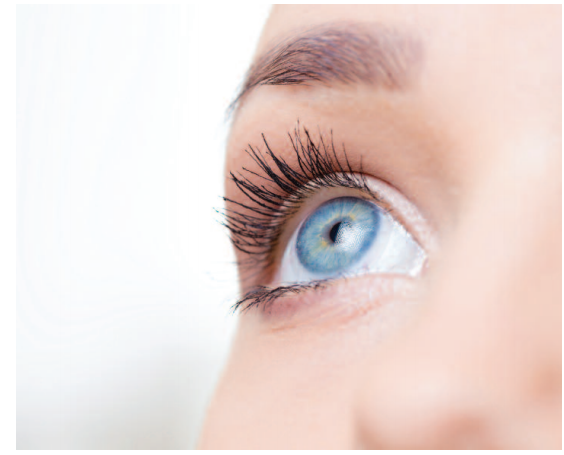Dry Eye Syndrome is a common condition which can cause patients severe discomfort and impede overall quality of life.
Dry eye syndrome (DES) – also known as keratoconjunctivitis sicca – is believed to affect almost ten per cent of the general population and it is thought that as many as one in three people over 70 years of age suffer from DES.
DES is a chronic multifactorial disease which arises when the tear film – the thin liquid layer that normally lubricates the eyes – becomes unstable and fails to do its job properly, leading to the eyes becoming red, inflamed (burning, itchy, gritty) and sometimes watery.
To manage symptoms of DES, initially there are practical lifestyle and environmental changes that patients can make to help relieve their symptoms. Let’s take a look:
Think about the blink!
Every time you blink, new tears are produced and spread across the surface of the eye. Thanks to the increase in time spent looking at computer screens, however, many patients do not blink enough. Suggest that they take regular breaks from their computer, phone or tablet and that they become more conscious about how often they blink.
Recommend the ‘20-20-20 Rule’
The 20-20-20 rule says that for every 20 minutes spent looking at a screen, a person should look at an object 20 feet away for 20 seconds. Following this rule is a great way to remember to take frequent breaks. This should reduce eye strain caused by looking at digital screens for too long.
Staying hydrated
Keeping the body hydrated is essential for good health, but hydration is equally important for the eyes. Without adequate moisture, eyes can become dry and uncomfortable. Recommend drinking eight to 10 glasses of water every day to keep the entire body hydrated.
Omega-3 Essential
Fatty Acids
Omega-3s in the form of eicosapentaenoic acid (EPA) and docosahexaenoic acid (DHA) can play a role in the structure of the outer lipid layer of the tear film which in turn acts to reduce evaporation of the aqueous (watery) layer.
Recommend increasing intake of Omega-3s through natural food sources such as oily fish, walnuts, flax seeds, chia seeds etc. If this is not sustainable or cannot be achieved due to allergies, recommend an Omega-3 supplement with high levels of EPA and DHA. In addition, preservative free Dry Eye sprays containing Omega-3 in the form of seed buckthorn seed oil are a good alternative as they act to stabilise the tear film and slow down its rate of evaporation.
Should the above practical advice not fully relieve symptoms, there are specific tailored management regimes which should be considered. These regimes are based on expert recommendations outlined in the Tear Film and Ocular Surface Society (TFOS) DEWSII report1. One such regime is the Heat-Cleanse-Hydrate (HCH) regime.
Heat
Applying a moist heat eye mask onto closed eyelids for ten minutes can help soften clogged oils in the eyelid glands. This allows the oils to flow more freely onto the natural tear film and help prevent the tears from evaporating from the surface of the eye. Moist heat is important, as dry heat may exacerbate symptoms further. Following the heated eye mask, suggest that the patient gently massages their eyelids using their forefinger, as this will help to push the oil out from the eyelid glands.
Cleanse
Cleansing eyelids daily will help keep debris, bacteria and excess oils that can often be associated with other common eye conditions such as Blepharitis and Meibomian Gland Dysfunction (MGD) under control. Preservative free cleansing gels and lid wipes are recommended as they are easy to use and soft on the most sensitive skin. Recommend using twice daily as part of a morning and nightly ritual for best results. Gels and wipes supplemented with tea tree oil (TTO), a natural anti-bacterial and Hyaluronic acid, will help to further relieve dry eye symptoms whilst managing underlying conditions.
Hydrate
DES is commonly managed by re-establishing or hydrating the already unstable tear film. For effective relief of dry eye symptoms, experts recommended to use preservative-free products1, since preservatives can cause further irritation to the surface of the eye. Other considerations include how long the drops will remain on the eyes surface to relieve symptoms, how long the drops will remain sterile and how many drops the patient can get from the bottle. Recommending a bottle that dispenses measured drops will help avoid unnecessary wastage and ensure best value for money.
In addition to artificial tear products during the day, patients may experience a worsening of dry eye symptoms at night. Preservative free paraffin ointments should be recommended as their denser consistency will lead to longer periods of lubrication overnight. Consider paraffin ointments with a low melting point which will allow for an easy and comfortable spread across the eye. Ointments supplemented with Vitamin A further help to protect the cornea and conjunctiva during the night.
Night-time dry eye
Many patients who suffer from dry eye will complain that they experience a flare-up, either during the night or when they wake in the morning. This can happen whilst a patient is sleeping, when their blood pressure, body temperature and metabolism all drop leading to reduced tear production. Patients can also sleep with their eyelids slightly open, and may find that when they awaken, their eyes feel inflamed and quite painful. Consider preservative free paraffin ointments with a low melting point for extended overnight lubrication and comfort.
Reference: 1. Jones, Lyndon, et al. “TFOS DEWS II management and therapy report.” The ocular surface 15.3 (2017): 575-628.


